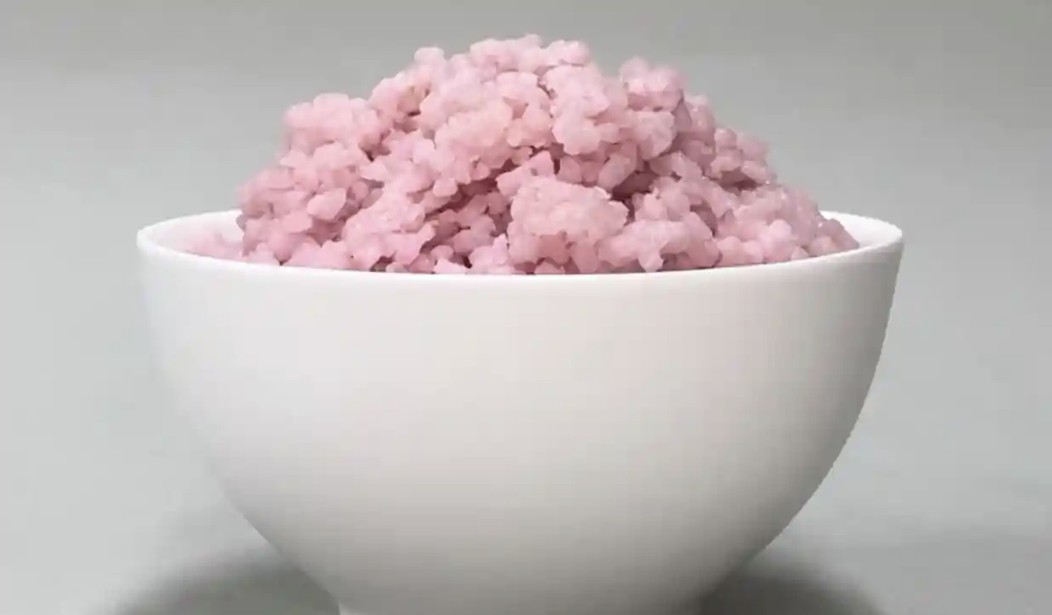It's new! It's nutritious! It looks like an eight-year-old threw up her birthday cake! It sat around in cultured fish gelatin for a week and a half! And if Prof. Jinkee Hong of South Korea's Yonsei University has his way, it's what's for dinner!
"What is it?" I can almost hear you ask with not-at-all-concealed contempt.
It's the latest completely scientifical meat substitute, almost certainly safe for human consumption and nearly ready for your dining pleasure.
It's beef rice.
I'll pause here a moment while you get a glass of something to wash that sudden and unexpected taste out of your mouth.
"How is beef rice manufactured?" I can almost hear you ask with no small amount of trepidation in your voice. Well, when a bull and a rice paddy love each other very much, and are acting within the confines of a non-traditional marriage...
I kid, I kid.
The Guardian reported this week — on Valentine's Day of all days to get that stomach flipping — on the process developed by Prof. Hong and his team to create an "affordable source of protein than traditional beef" that would also feature a much smaller carbon footprint than a delicious ribeye on the hoof.
They start with traditional rice grains and cover them (without specifying exactly how) with fish gelatin. The gelatin-covered rice is then seeded with skeletal muscle and fat stem cells taken from "Hanwoo cattle slaughtered at the local abattoir." The rice was then allowed to age for nine to 11 days, like fine wine made from skeletal muscle, stem cells, and fish gelatin.
According to the report, the scientists hope in the future to use lab-grown meat and fat stem cells. You'll have to wish them lots of luck because, as I reported back in September, the process is difficult, time-consuming, and comically expensive:
Upside Foods was founded in 2015 (originally as “Memphis Meats”) to use science to make lab-grown meat that is made from animal tissue, more or less. The Wall Street Journal reported two years later that the company’s technology could “yield one pound of chicken meat for less than $9,000.”
And you thought Bidenflation was bad?
But there was progress. The $9,000-per-pound cost was “half of what it cost the company to produce its beef meatball about a year ago.”
I don't know anything about Hanwoo cattle, but not even the priciest Wagyu costs anything like $9,000 per pound.
What strikes me most about this story isn't Hong's lame endorsement of his product, which he says "offers a pleasant and novel flavor experience," although the rice itself is "more brittle" than rice that hasn't been slathered in fish goo and injected with cow stuff. It's just how little extra nutrition is gained after so much effort. Beef rice contains just 8% more protein and 7% more fat than untampered rice.
But beef rice isn't about the flavor, and it isn't much about the nutrition. It's about reducing the carbon footprint of cattle ranching. Per gram of protein, beef rice generates much less carbon than a cow does. But you'd have to eat a LOT more beef rice to get the same nutritional value.
Prof Hanna Tuomisto, who researches sustainable food systems at the University of Helsinki, doubted that the rice would have a major impact. The end product contained 4.8g of cultivated beef cells per kg of rice, she said, meaning only 0.5% was meat and 99.5% rice. “The product is still basically rice and would be used to replace rice or other carbohydrate sources in a meal,” she said. “For replacing meat, the percentage of the protein in the final product would need to be higher.”
None of these various meat replacements are as bad as the Soros-esque "you'll sit in the dark and eat the bugs," but I sure do get the feeling they're an important step on the public's journey there.
Recommended: It's Official: Everybody Knows Biden's Brain Is Pudding










Join the conversation as a VIP Member